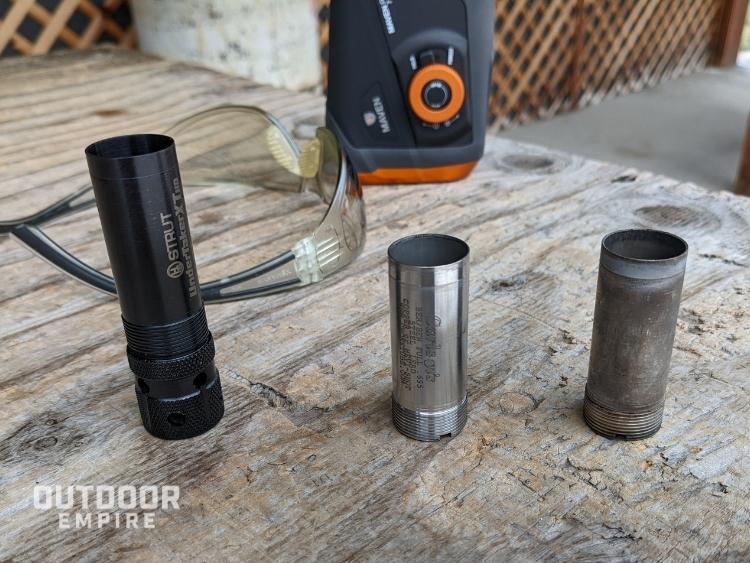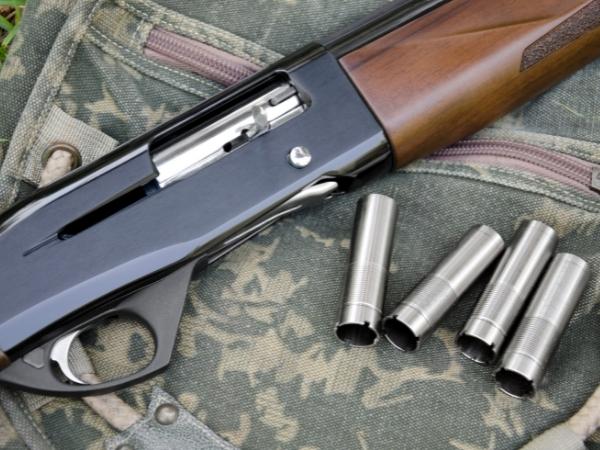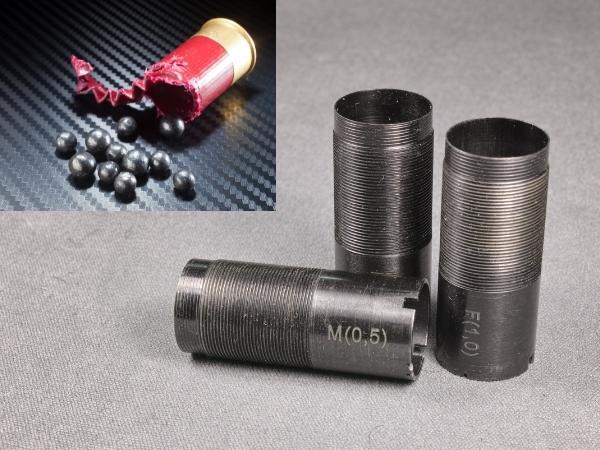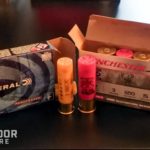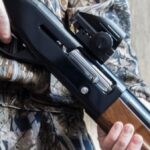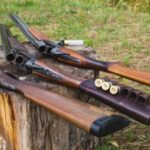One of the greatest developments in shotgun technology was the discovery that constricting the barrel right before the end tightened up your shotgun’s pattern.
A tighter pattern is effective out to a longer distance, making your shotgun more reliable at taking birds and breaking clays.
Nowadays, almost every shotgun barrel on the market is threaded to receive a choke tube.
But there are so many choke sizes and types. How is a hunter to choose the right one?
Typically, the farther out your target, the tighter you want your choke. For example, a Modified choke is good for pheasants, whereas you may want a Super Full choke for turkey. But if you’re using steel shot, loosen up your choke by one level.
If that doesn’t make sense, then continue reading. I’ll define every word I used, from constriction to Super Full, to help you understand the sometimes vague world of hunting chokes.
What are Shotgun Chokes and How Do They Work?
A choke is a constriction at the end of a shotgun’s bore. The bore is the inside of the barrel.
Shotgun bores were, originally, the same internal diameter from the forcing cone (just in front of the chamber to the bore) to the muzzle.
Almost two hundred years ago, though, some adventuring gunsmiths discovered something that would change the shotgun world forever: If you reduce the bore diameter right at the end of the barrel, your shotgun’s pattern decreases in size.
Pattern
Pattern” refers to the size and density of the cloud of shot as it flies through the air and impacts the target. As the lead flies, the pellets separate and move away from each other.
The word is also used as a verb because you can “pattern” your shotgun by shooting a large piece of paper and seeing where every pellet ends up.
A smaller starting pattern means that this pellet divergence will take longer to come into effect. This keeps the cloud denser for longer.
In other words, tightening the bore extends the range of your shotgun.
Constriction
“Constriction” is how much smaller the choke is than the bore diameter. There are many names for different constriction levels, which I’ll cover later.
Constriction is most commonly measured in hundredths of inches or even thousandths. A Skeet choke, for example, has been constricted from the bore by 0.005 inches.
Another way to measure choke is by the percentage of pellets that land within a 30″ circle at 40 yards.
The tighter the constriction, the denser the cloud of shot, and the longer the range. Simple enough.
However, a too-tight choke can impose an effective minimum range for your shotgun. It’s possible for a pattern to be too tight for super close-in shots.
It’s also possible for a choke to be tight enough for a certain load to “blow out” when all the pellets jumble their way through the tight space. This results in a pattern that widens up much earlier than anticipated.
An easy way to diagnose a blown-out pattern is if the holes in paper resemble a donut, with far more targets around the outside of the circle and few in the middle.
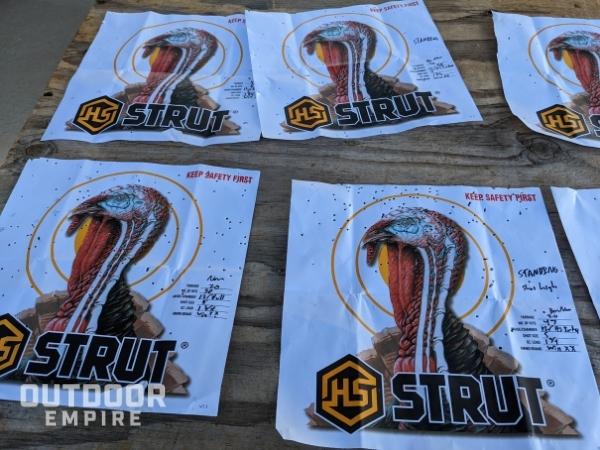
Chokes can either be part of the barrel or a separate piece of metal.
Today, most choke tubes are threaded into the end of your shotgun, allowing you to swap constrictions depending on what you’re shooting.
Some people call these “screw chokes.” Chokes integrated with the barrel are called “fixed chokes.”
Some report that fixed chokes have a greater effect than a screw-in choke of the same constriction.
Shotgun Chokes Sizes and Their Uses
Choke sizes are, frustratingly, not entirely standardized. Many manufacturers have slightly different measurements because their bore size is somewhat different.
Beretta, for example, drops only 0.004″ between Cylinder and Skeet chokes.
We’ll start with a chart of the common choke names and constrictions before getting into the details of how to use each.
| Choke Size | UK Name | Constriction* | % Pattern in Circle | Identification** | Effective Range*** |
| Negative | -0.005″ | 35 | 15 | ||
| Cylinder | True Cylinder | 0.000″ | 40 | 5 | 20 |
| Skeet | 1/8 or Improved Cylinder | 0.005″ | 45 | 23 | |
| Improved Cylinder | 1/4 | 0.010″ | 50 | 4 | 25 |
| Light Modified | 3/8 | 0.015″ | 55 | 30 | |
| Modified | 1/2 | 0.020″ | 60 | 3 | 3 |
| Improved Modified | 3/4 | 0.025″ | 65 | 2 | 35 |
| Light Full | 0.030″ | 68 | 38 | ||
| Full | 1/1 | 0.035″-0.040″ | 70 | 1 | 40 |
| Extra Full | 0.040″-0.045″ | 73 | 45+ | ||
| Super Full / Extra Extra Full / Turkey | 0.045″-0.55” | 75 | 45+ |
* I didn’t include bore size in this chart because it can vary from manufacturer to manufacturer. 12 gauge is supposed to have a bore size of 0.729″ but SAAMI spec allows for up to 0.745″. Also, the nominal bore size doesn’t actually matter when it comes to patterning. Only constriction matters.
** Some chokes are identified with a number of notches or stars. These can be on the barrel with fixed chokes.
*** Effective ranges given are for lead birdshot and are a rough guide.
Here’s an important caveat before proceeding:
Each shotgun behaves individually. In addition, each shotshell load in each shotgun behaves individually.
Take the following information as a starting point for your shotgun. Then take it to the range, pattern your gun, and use what you learn to determine how to get the desired results.
Choke Sizes
Negative
A negative choke is wider than the shotgun’s bore.
The main use for a negative choke is with self-defense firearms when you want as wide a pattern as possible in as short a distance as possible to maximize your chances of hitting an assailant.
(True) Cylinder
A Cylinder choke has no constriction.
It’s used for home defense, slug hunting, and close-in bird shooting such as ducks, pheasants, and quail.
Skeet
Skeet chokes are named because they’re most commonly used for skeet shooting when you have to make two rapid shots on clay birds at a relatively close range.
When you let them get close, these chokes are also suitable for quail, grouse, early-season pheasants, and ducks.
Improved Cylinder
Improved chokes are commonly used while hunting. You can use them with rifled slugs and for small birds and/or close-range birds, including ducks, quail, chukar, grouse, partridges, pheasants, and greater prairie chicken.
IC is also a common choke size for trap shooting.
Light Modified
Light modified is a relatively rare choke used to get a slightly denser pattern against smaller birds or for advanced skeet shooters.
Modified
Some people recommend that if you’re unsure what choke you need, use a modified choke.
Modified chokes are good against various game animals, from ducks to doves and rabbits to squirrels.
MOD is also a common trap shooting choke size for advanced shooters.
Improved Modified
Sometimes called IM, this choke size is recommended for longer-distance shots on small game animals, especially later in the season when they’re more likely to spook and take flight before you can get close.
It’s a fairly common choke size for hunting ptarmigan if you find yourself in Alaska.
Light Full
Fuller chokes are good for bringing more pellets onto a single animal, making them more effective at taking down larger birds like turkeys and geese.
Some hunters also use them against larger ducks, especially at longer ranges.
Full
Full chokes are the go-to for geese as well as turkey.
Some trap shooters transition to full choke as they gain experience, especially once they start taking handicaps and have a longer distance to shoot.
Extra Full
Extra Full chokes are for squeezing a little extra range when shooting large ducks, geese, and turkey.
Super Full / Extra Extra Full / Turkey
The least-standardized choke size, these chokes are intended to let you take out turkey with headshots at relatively long ranges.
Different Types of Hunting Chokes
If the world of shotgun chokes for hunting wasn’t confusing enough already, there are different types of choke tubes.
The Manufacturer
Many shotgun manufacturers use a different threading pattern, sometimes in a different location in the bore, making their choke tubes incompatible with the competition’s chokes.
Also, some manufacturers have different fitting choke tubes for different shotguns. Browning especially has the Standard Invector, Invector Plus, and Invector-DS; these chokes do not interchange.
This means you have to know what type of choke your shotgun uses.
Not all shotgun manufacturers have proprietary threading patterns, though. Overseas manufacturers love to thread their guns with Remington chokes, for example.
But don’t confuse that with the Remington Pro Bore!
These different mounting thread positions can theoretically affect your shotgun’s patterns but for most of us, it doesn’t matter.
Just get chokes that fit your gun.
Materials and Lengths
Material is essential because some chokes are not compatible with steel shot. The steel, traveling at a high velocity, can damage softer metals. Always confirm shot compatibility when using anything except for lead birdshot.
As for length, longer chokes tend to provide denser shot patterns than shorter chokes of the same constriction.
This is because a longer taper lets the pellets gently reposition, so there’s less turbulence once they leave the bore.
This is good for hunting at longer ranges or breaking clays with a handicap. However, you may want to avoid extended chokes when shooting at close-in targets.
Finally, some extended choke tubes have porting and small holes to divert the expanding gas.
The idea is the same as a rifle’s muzzle brake but, to be honest, it’s basically a marketing scheme. Shotguns do not have the required gas pressure lateral ports to reduce recoil effectively.
Some people see a reduction in muzzle climb with ports on top of the barrel. However, because choke tubes are screwed in, their ports must be equidistantly spaced around the port.
At best, you’ll see no effect with a ported choke tube. At worse, you get a bit more noise and a lighter wallet.
Shotgun Choke Installation and Maintenance
Not every shotgunner knows they have to maintain their chokes when cleaning their shotgun.
Eventually, these hunters will find themselves with a choke that’s almost welded inside their barrel!
No choke has a 100% seal between its base and the barrel. A little bit of gas will always blow between the choke tube and the bore, and a tiny bit will get into the threading.
Over time, this will deposit carbon residue. As it builds up, it will effectively glue the choke tube to the barrel.
To prevent this, you must remove your choke and clean it regularly. I do it whenever I disassemble any part of my shotgun for cleaning.
And remember to clear your shotgun of ammunition before cleaning it. Make sure the magazine and every chamber are clear with both a visual and physical inspection!
You need to use the correct type of wrench to remove the choke. It’s like a screwdriver and is often called a choke key.
One likely came with your shotgun but that’s not always the case. You can get universal choke tube wrenches, but I’d use one designed for your specific choke, otherwise, they may not fit properly.
Extended chokes don’t need wrenches, by the way. Just grab the outside of the choke tube!
Once the tube is out of your gun, clean it as you would any other gun part. Use solvent and a brush to remove any carbon residue, then apply gun oil to the choke’s inside and outside.
Some shotgunners apply a small amount of grease to the threads instead of oil.
When installing the choke, you do not want to put too much force into it.
You want to bottom out the choke tube but do not torque it in. Doing so can permanently damage the threads inside your barrel, which is an expensive repair.
As for fixed tubes, well, they’re part of the barrel! No special care is necessary.
Choke Tubes and Hunting Slugs
What about deer hunting with a slug?
Some choke sizes are compatible with slugs, actually.
A little bit of constriction is fine for lead slugs. But you don’t really want to get any tighter than an Improved Cylinder if you’re shooting a lot.
However, the occasional Foster or Brenneke slug shot won’t damage even a Full choke tube because the outer vanes will collapse, swaging the slug through the choke. They may lose accuracy from being squeezed through, though.
You can buy rifled choke tubes, which impart spin as the slug travels through. This improves accuracy.
Don’t use rifled choke tubes nor a sabot slub with a rifled slug, though. In both cases, the choke’s rifling can damage the slug, decreasing accuracy.
Remember:
You want the slug or the choke to be rifled, not both!
Conclusion
Finding the right choke for what you’re shooting can make you more consistent, whether hunting or shooting clays.
Unfortunately, choke tubes are not an exact science. Every manufacturer makes them slightly differently, and every load passes through them slightly differently.
You can take in all the advice you want about chokes, but you need to get out and practice with your shotgun to ensure you get the pattern you want at the distance you’ll be shooting.
If you’re unsure where to start, I’d recommend starting with a Modified choke.
Pattern your shotgun by shooting a large sheet of paper at the range you expect to be shooting your target. Too dense? Use a lighter choke. Too wide? Use a tighter choke.
I’m a fan of Carlson’s extended choke tubes. Which chokes do you use?
FAQs
Can you fire a shotgun without a choke?
If your shotgun is threaded to receive a screw-in choke, then DO NOT fire that gun without a choke installed. The threading is thin and easily damaged.
Can you use slugs with chokes?
Yes, you can fire a lead slug through most chokes, so long as they are not Extra Full or tighter. Improved Cylinder is the tightest recommended choke size.

